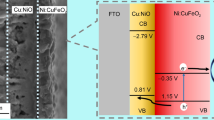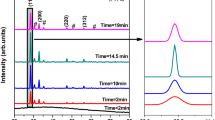Abstract
Copper oxides are considered to be very promising materials for promoting a hydrogen evolution reaction (HER). However, some CuO features, such as the recombination of charge carriers, electron diffusion length, and the chemical stability need to be improved. In this work, NiOx was studied as co-catalyst to FTO/CuO, and the films were physically characterised by X-ray diffraction (XRD), X-ray photoelectron spectroscopy (XPS), and scanning electron microscopy (SEM). The photo-electrochemical activity and stability toward the HER were evaluated by depositing films on fluorine-tin doped oxide (FTO) substrate. Although, the CuO (− 3.61 eV) and NiOx (− 1.13 eV) conduction band positions, estimated by UV-Vis diffuse reflectance and the Mott–Schottky measurements, did not allow electronic transfer from CuO to NiOx, the formation of a thin layer of NiOx on CuO was beneficial for the activity of this material. The best CuO/NiOx film exhibited a photocurrent density of − 1.02 mA cm−2 at 0 V vs. RHE, which was higher than that for CuO (− 0.92 mA cm−2). A mechanism of electron transfer between CuO and NiOx is proposed. The absorption of visible light by CuO leads to the generation of electron-hole pair. Part of the photogenerated electrons are trapped by the NiOOH present in the NiOx layer, as demonstrated by XPS. The oxy-hydroxide is reduced to metallic Ni, and this species acts as a catalyst for the hydrogen evolution reaction. Due to the increase in interfacial pH caused by the evolution reaction of H2, the formed metallic Ni can be regenerated to NiOx.









Similar content being viewed by others
References
Wang JY (2015) Barriers of scaling-up fuel cells: cost, durability and reliability. Energy 80:509–521
He H, Liao A, Guo W, Luo W, Zhou Y, Zou Z (2019) State-of-the-art progress in the use of ternary metal oxides as photoelectrode materials for water splitting and organic synthesis. Nano Today 28:100763
Chen X, Shen S, Guo L, Mao SS (2010) Semiconductor-based photocatalytic hydrogen generation. Chem Rev 110(11):6503–6570
Walter MG, Warren EL, McKone JR, Boettcher SW, Mi QX, Santori EA, Lewis NS (2010) Solar water splitting cells. Chem Rev 110(11):6446–6473
Chen J, Yang D, Song D, Jiang J, Ma A, Hu MZ, Ni C (2015) Recent progress in enhancing solar-to-hydrogen efficiency. J Power Sources 280:649–666
Medina M, Corradini PG, Mascaro LH (2019) Facile one-step electrodeposition fabrication of amorphous MoS2 catalysts in titanium for hydrogen evolution reaction. J Braz Chem Soc:1–9
Ismail AA, Bahnemann DW (2014) Photochemical splitting of water for hydrogen production by photocatalysis: a review. Sol Energy Mater Sol Cells 128:85–101
Pham TA, Ping Y, Galli G (2017) Modelling heterogeneous interfaces for solar water splitting. Nat Mater 16(4):401–408
Gupta NM (2017) Factors affecting the efficiency of a water splitting photocatalyst: a perspective. Renew Sust Energ Rev 71:585–601
Li J, Cui M, Guo Z, Liu Z, Zhu Z (2014) Synthesis of dumbbell-like CuO–BiVO4 heterogeneous nanostructures with enhanced visible-light photocatalytic activity. Mater Lett 130:36–39
Bagal IV, Chodankar NR, Hassan MA, Waseem A, Johar MA, Kim D-H, Ryu S-W (2019) Cu2O as an emerging photocathode for solar water splitting - a status review. Int J Hydrogen Energ 44(39):21351–21378
Paracchino A, Laporte V, Sivula K, Grätzel M, Thimsen E (2011) Highly active oxide photocathode for photoelectrochemical water reduction. Nat Mater 10(6):456–461
Masudy-Panah S, Siavash Moakhar R, Chua CS, Tan HR, Wong TI, Chi D, Dalapati GK (2016) Nanocrystal engineering of sputter-grown CuO photocathode for visible-light-driven electrochemical water splitting. ACS Appl Mater Interfaces 8(2):1206–1213
Dubale AA, Tamirat AG, Chen H-M, Berhe TA, Pan C-J, Su W-N, Hwang B-J (2016) A highly stable CuS and CuS–Pt modified Cu2O/CuO heterostructure as an efficient photocathode for the hydrogen evolution reaction. J Mater Chem A 4(6):2205–2216
Lin C-Y, Lai Y-H, Mersch D, Reisner E (2012) Cu2O|NiOx nanocomposite as an inexpensive photocathode in photoelectrochemical water splitting. Chem Sci 3(12):3482–3487
Septina W, Prabhakar RR, Wick R, Moehl T, Tilley SD (2017) Stabilized solar hydrogen production with CuO/CdS heterojunction thin film photocathodes. Chem Mater 29(4):1735–1743
Morales-Guio CG, Tilley SD, Vrubel H, Grätzel M, Hu X (2014) Hydrogen evolution from a copper(I) oxide photocathode coated with an amorphous molybdenum sulphide catalyst. Nat Commun 5(1):3059
Ren X, Gao P, Kong X, Jiang R, Yang P, Chen Y, Chi Q, Li B (2018) NiO/Ni/TiO2 nanocables with Schottky/p-n heterojunctions and the improved photocatalytic performance in water splitting under visible light. J Colloid Interface Sci 530:1–8
Juma AO, Arbab EAA, Muiva CM, Lepodise LM, Mola GT (2017) Synthesis and characterization of CuO-NiO-ZnO mixed metal oxide nanocomposite. J Alloys Compd 723:866–872
Golden TD, Shumsky MG, Zhou Y, VanderWerf RA, Van Leeuwen RA, Switzer JA (1996) Electrochemical deposition of copper(I) oxide films. Chem Mater 8(10):2499–2504
Dolai S, Sarangi SN, Hussain S, Bhar R, Pal AK (2019) Magnetic properties of nanocrystalline nickel incorporated CuO thin films. J Magn Magn Mater 479:59–66
Jagadale AD, Kumbhar VS, Dhawale DS, Lokhande CD (2013) Potentiodynamically deposited nickel oxide (NiO) nanoflakes for pseudocapacitors. J Electroanal Chem 704:90–95
Wu M-S, Huang Y-A, Yang C-H (2008) Capacitive behavior of porous nickel oxide/hydroxide electrodes with interconnected nanoflakes synthesized by anodic electrodeposition. J Electrochem Soc 155(11):A798–A805
Huang M, Li F, Zhang YX, Li B, Gao X (2014) Hierarchical NiO nanoflake coated CuO flower core–shell nanostructures for supercapacitor. Ceram Int 40(4):5533–5538
Xu H, Zhang J, Rehman AU, Gong L, Kan K, Li L, Shi K (2017) Synthesis of NiO@CuO nanocomposite as high-performance gas sensing material for NO2 at room temperature. Appl Surf Sci 412:230–237
Hou L, Zhang C, Li L, Du C, Li X, Kang X-F, Chen W (2018) CO gas sensors based on p-type CuO nanotubes and CuO nanocubes: morphology and surface structure effects on the sensing performance. Talanta 188:41–49
Wang W, Bai C, Zhang L (2019) CuO/graphene oxide composite as a highly active catalyst for one-step amination of benzene to aniline. Catal Commun 125:1–5
Khorsand Zak A, Majid WHA, Ebrahimizadeh Abrishami M, Yousefi R, Parvizi R (2012) Synthesis, magnetic properties and X-ray analysis of Zn0.97X0.03O nanoparticles (X = Mn, Ni, and co) using Scherrer and size–strain plot methods. Solid State Sci 14(4):488–494
Sen B, Kuyuldar E, Şavk A, Calimli H, Duman S, Sen F (2019) Monodisperse rutheniumcopper alloy nanoparticles decorated on reduced graphene oxide for dehydrogenation of DMAB. Int J Hydrogen Energ 44(21):10744–10751
Sui L, Yu T, Zhao D, Cheng X, Zhang X, Wang P, Xu Y, Gao S, Zhao H, Gao Y, Huo L (2019) In situ deposited hierarchical CuO/NiO nanowall arrays film sensor with enhanced gas sensing performance to H2S. J Hazard Mater:121570
Biesinger MC, Payne BP, Lau LWM, Gerson A, Smart RSC (2009) X-ray photoelectron spectroscopic chemical state quantification of mixed nickel metal, oxide and hydroxide systems. Surf Interface Anal 41(4):324–332
Lun T-T, Liu C-Q, Wang N, Zhai X-N, Song M-S, Ge Q, Zhang X-Y, Liu S-M, Wang H-L, Jiang W-W, Ding W-Y (2019) Preparation of compact CuO films by sol-gel spin coating technique. Mater Lett 257:126745
Senobari S, Nezamzadeh-Ejhieh A (2018) A comprehensive study on the enhanced photocatalytic activity of CuO-NiO nanoparticles: designing the experiments. J Mol Liq 261:208–217
Lim Y-F, Chua CS, Lee CJJ, Chi D (2014) Sol–gel deposited Cu2O and CuO thin films for photocatalytic water splitting. Phys Chem Chem Phys 16(47):25928–25934
Emin S, Abdi FF, Fanetti M, Peng W, Smith W, Sivula K, Dam B, Valant M (2014) A novel approach for the preparation of textured CuO thin films from electrodeposited CuCl and CuBr. J Electroanal Chem 717-718:243–249
Wang P, Wen X, Amal R, Ng YH (2015) Introducing a protective interlayer of TiO2 in Cu2O–CuO heterojunction thin film as a highly stable visible light photocathode. RSC Adv 5(7):5231–5236
Nakayama S, Kaji T, Shibata M, Notoya T, Osakai T (2007) Which is easier to reduce, Cu2O or CuO ? J Electrochem Soc 154(1):C1–C6
Cremades A, Piqueras J (2002) Study of carrier recombination at structural defects in InGaN films. Mater Sci Eng B 91-92:341–344
Jang W-L, Lu Y-M, Hwang W-S, Chen W-C (2010) Electrical properties of Li-doped NiO films. J Eur Ceram Soc 30(2):503–508
Zhang K, Shi X-J, Kim JK, Park JH (2012) Photoelectrochemical cells with tungsten trioxide/Mo-doped BiVO4 bilayers. Phys Chem Chem Phys 14(31):11119–11124
Dey KK, Gahlawat S, Ingole PP (2019) BiVO4 optimized to nano-worm morphology for enhanced activity towards photoelectrochemical water splitting. J Mater Chem A 7(37):21207–21221
Singh AK, Sarkar D (2019) Enhanced light absorption and charge carrier management in core-shell Fe2O3@nickel nanocone photoanodes for photoelectrochemical water splitting. Chemcatchem 11(24):6355–6363
Zhang Z, Wang P (2012) Highly stable copper oxide composite as an effective photocathode for water splitting via a facile electrochemical synthesis strategy. J Mater Chem 22(6):2456–2464
Rao KV, Smakula A (1965) Dielectric properties of cobalt oxide, nickel oxide, and their mixed crystals. J Appl Phys 36(6):2031–2038
Fingerle M, Tengeler S, Calvet W, Mayer T, Jaegermann W (2018) Water interaction with sputter-deposited nickel oxide on N-Si photoanode: cryo photoelectron spectroscopy on adsorbed water in the frozen electrolyte approach. J Electrochem Soc 165(4):H3148–H3153
Yu J, Hai Y, Cheng B (2011) Enhanced photocatalytic H2-production activity of TiO2 by Ni(OH)2 cluster modification. J Phys Chem C 115(11):4953–4958
Funding
The authors thank the São Paulo Research Foundation (FAPESP) for the financial assistance for the project and for the fellowships that were granted (grant no. 2017/11986-5, grant no. 2018/16401-8, grant no. 2017/12794-2, FAPESP/CDMF #2013/07296-2), and Shell and the strategic importance of the support given by ANP (Brazil’s National Oil, Natural Gas and Biofuels Agency) through the R&D levy regulation. The authors also thank the Coordenação de Aperfeiçoamento de Pessoal de Nível Superior (CAPES) - Finance Code 001, and the Conselho Nacional de Pesquisa e Desenvolvimento (CNPq, #141092/2018-1) for the fellowships that were granted.
Author information
Authors and Affiliations
Corresponding author
Additional information
Publisher’s note
Springer Nature remains neutral with regard to jurisdictional claims in published maps and institutional affiliations.
Electronic supplementary material
ESM 1
(DOCX 265 kb)
Rights and permissions
About this article
Cite this article
Santos, H.L.S., Corradini, P.G., Andrade, M.A.S. et al. CuO/NiOx thin film–based photocathodes for photoelectrochemical water splitting. J Solid State Electrochem 24, 1899–1908 (2020). https://doi.org/10.1007/s10008-020-04513-5
Received:
Revised:
Accepted:
Published:
Issue Date:
DOI: https://doi.org/10.1007/s10008-020-04513-5




